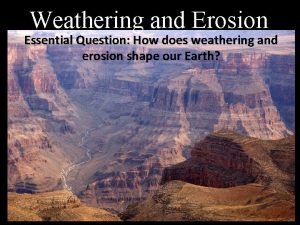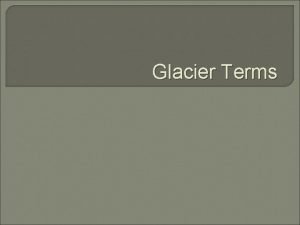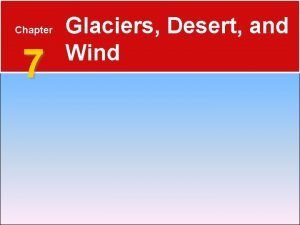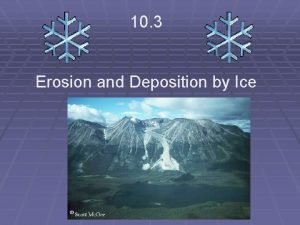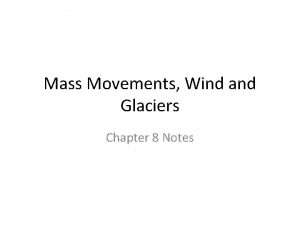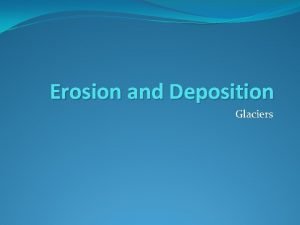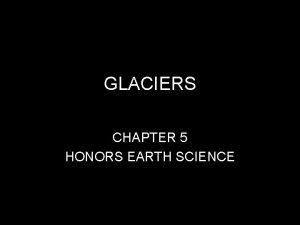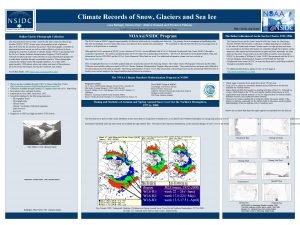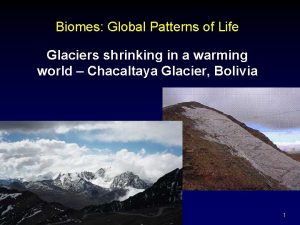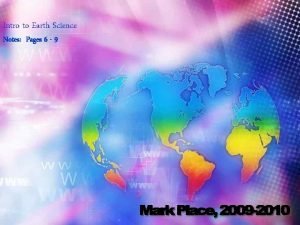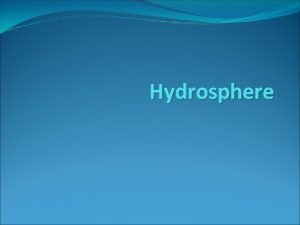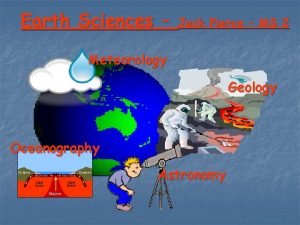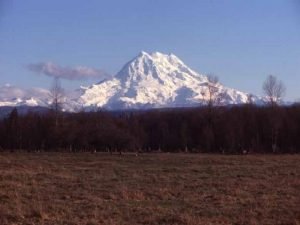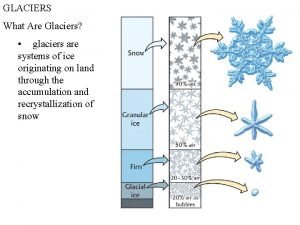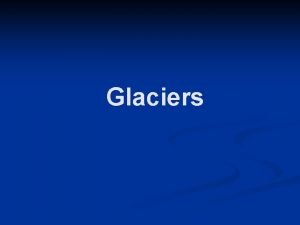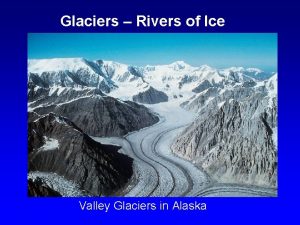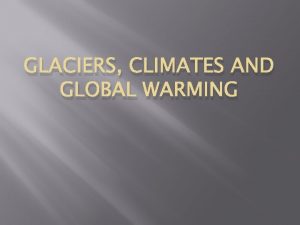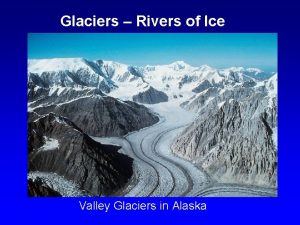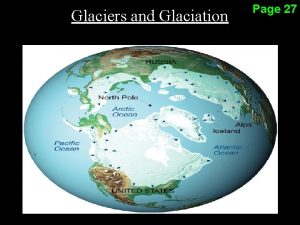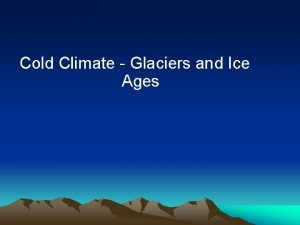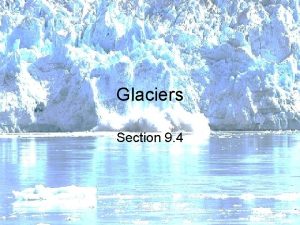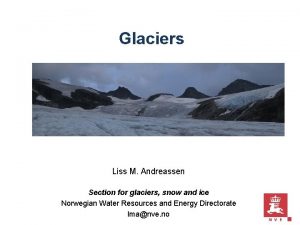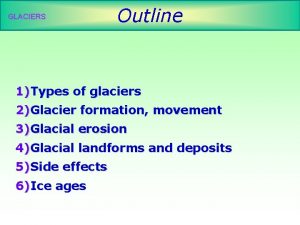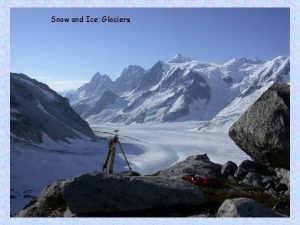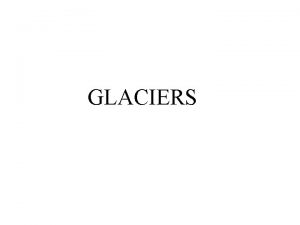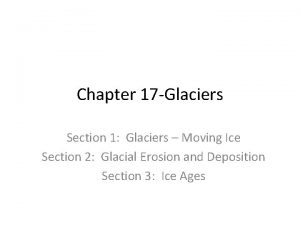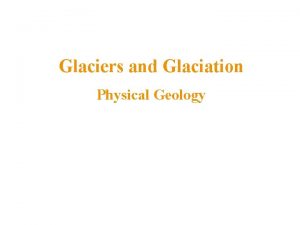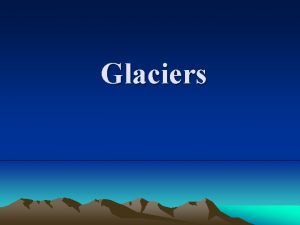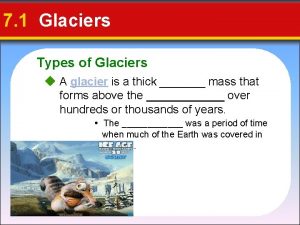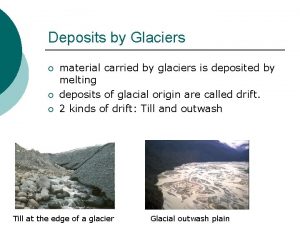Earth Science 7 1 A Glaciers Glaciers As
























- Slides: 24

Earth Science: 7. 1 A Glaciers

Glaciers � As recently as 15, 000 years ago, up to 30 percent of earth’s land was covered by an glacial ice. � Earth was covered by an ice age; a period of time when much of Earth’s land surface was covered by glaciers. � A glacier is a thick ice mass that moves slowly over the land surface.

Glaciers � Glaciers originate on land in places where more snow falls each winter than melts in summer. � The snowline is the lowest elevation in an area that remains covered in snow all year. � At the poles, the snowline happens at sea level. � Closer to the equator, the snowline occurs only at the very tops of tall mountains.

Glaciers � Instead of melting away, snow above the snowline accumulates and compacts. � The compressed snow first crystallizes into course ice grains. � Further pressure from the weight of additional snow changes the course grains into interlocking grains of glacial ice.

Glaciers � Glaciers appear to be motionless. Glaciers actually move very, very slowly. � If you sit near a glacier for a period of time you will hear cracks, creaks, and groans as the ice mass is slowly pulled downhill by gravity. � Glaciers are also important agents of erosion. Like rivers, they accumulate, transport, and deposit sediment as they move along their course grinding down rocks, boulders, and mountains in their path.

Valley Glaciers � Thousands of small glaciers exist in mountains around the world. � Unlike mountain streams, mountain glaciers advance only a few millimeters to meters a day. � Valley Glaciers slowly advance down a valley that was originally occupied by a stream or river.

Valley Glaciers � A valley glacier is a stream of ice that flows between steep rock walls from a place near the top of a mountain valley.

Ice Sheets � Ice sheets are enormous ice masses that flow in all directions from one or more centers; much larger than glaciers. � Ice sheets are sometimes called continental ice sheets because they cover very large regions where the climate is extremely cold. � The only present day ice sheets are those covering Antarctica and Greenland Antarctic ice sheet Greenland ice sheet

Ice Sheets � Ice sheets covered much of North America during the last ice age. � The last two remaining ice sheets cover about 10% of Earth’s land area. � One ice sheet covers about 80% of Greenland averages about 1500 meters thick; 3000 meters in some places. Antarctic ice sheet Greenland ice sheet

Ice Sheets � Ice sheets covered much of North America during the last ice age. � The last two remaining ice sheets cover about 10% of Earth’s land area. � One ice sheet covers about 80% of Greenland averages about 1500 meters thick; 3000 meters in some places. Antarctic ice sheet Greenland ice sheet

Ice Sheets � The huge Antarctic ice sheet is nearly 4300 meters thick in places. � This glacier holds 80% of the world’s ice and nearly two thirds of the world’s fresh water. � If it melted, sea level would rise 60 – 70 meters and many of the world’s cities would disappear underwater. Antarctic ice sheet Greenland ice sheet

How Glaciers Move � We wonder how something as large as a glacier can move. � The movement of glaciers is referred to as flow. � Glacial flow happens in two ways: �Plastic flow �Basal slip

How Glaciers Move � Plastic flow involves movement within the ice. � Under pressure, the normally brittle ice begins to distort and change shape; a property known as plasticity. � The weight of the overlying ice puts pressure on the ice beneath, causing it to flow downhill with gravity. Plastic Flow

How Glaciers Move � Basal slip is the second cause of ice movement. � Due to gravity, the entire ice mass actually slips downhill. � The layers closest to the surface behave differently than the layers below.

How Glaciers Move � The uppermost zone of the glacier is not under enough pressure to have plasticity. Instead, it rides piggyback on the flowing ice below. � The plastic flow happens at about 50 meters below the glacier’s surface where the pressure increases. The greater the depth beneath the surface, the greater the plastic flow.

How Glaciers Move � The uppermost zone that does not have plasticity is brittle. We call this zone the zone of fracture. � The zone of fracture experiences tension whenever the glacier moves over rough terrain. This tension results in deep cracks called crevices. � Crevices can be 50 meters deep and are often covered by snow making them very dangerous to hikers who travel on glaciers.

How Glaciers Move � Rates of Glacial Movement: � Different glaciers move at different rates. � Some flow so slowly that trees and plants can grow in the debris on their surface. � Other glaciers move several meters a day. � Still other glaciers may alternate between periods of fast movement and periods of slow movement or no movement at all.

� Glaciers form whenever more snow falls in the winter than can melt in the summer. � Glaciers constantly gain and loose ice. Snow accumulates and ice forms in the head of the glacier in the zone of accumulation. � In the zone of accumulation; above the snowline, the glacier gains ice and forces movement. How Glaciers Move

How Glaciers Move � The area of the glacier below the snowline is where the glacier melts, losing ice and mass. � We call this area of glacial melting the zone of wastage. � In the zone of wastage is where the glacier breaks up and melts away.

How Glaciers Move � Glaciers lose ice when large pieces break off their front edge in a process called calving. � Calving creates icebergs when glaciers meet the ocean. � Because icebergs are slightly less dense than saltwater, they float low in the water. Only 10% of their mass is visible above water.

How Glaciers Move � The foot of a glacier, the bottom edge, can advance, retreat or remain in place. Which course it takes depends on the glacier’s budget. � The glacial budget is the balance between the amount of snow-ice accumulated at the top of the glacier (the zone of accumulation) and the amount of loss at the glacier’s foot ( the zone of wastage).

How Glaciers Move � If more ice forms at the top of the glacier than melts at the bottom, than the glacier advances. � If the ice melts faster at the bottom than the glacier accumulates at the top, than the glacier retreats. � If the glacier builds ice at the top at the same rate that it loses ice at the bottom; the glacier’s budget is in balance and the glacier remains stationary.

Glaciers: Key Concepts • Valley Glaciers are found in mountains. They are streams of ice that flow between steep rock walls from a place near where snow accumulates. • Ice sheets cover large regions where the climate is extremely cold. They are huge compared to valley glaciers. • The movement of glaciers is referred to as flow. Glacial flow happens in two ways: plastic flow and basal slip. • The glacial budget is the balance (or lack of balance) between accumulation at the top of the glacier and melting at the bottom of the glacier.

 Favorite lesson in science
Favorite lesson in science Glaciers cause erosion by abrasion and
Glaciers cause erosion by abrasion and Minnesota glaciers map
Minnesota glaciers map Alpine glacier vs continental glacier
Alpine glacier vs continental glacier Chapter 7 glaciers deserts and wind
Chapter 7 glaciers deserts and wind What are the two main types of glaciers
What are the two main types of glaciers Examples of mass movement
Examples of mass movement Landslides moving water wind and glaciers cause
Landslides moving water wind and glaciers cause Glaciers
Glaciers Chapter 5 glaciers oceans and landscapes
Chapter 5 glaciers oceans and landscapes Nsidc glaciers
Nsidc glaciers Bolivia glaciers
Bolivia glaciers Meteorological symbols for four types of fronts
Meteorological symbols for four types of fronts Earth science sol 2010
Earth science sol 2010 Earth science practical review
Earth science practical review Part d earth science regents
Part d earth science regents Earth science regents lab practical
Earth science regents lab practical Earth science grade 9
Earth science grade 9 Dynamic equilibrium earth science
Dynamic equilibrium earth science Hydrosphere includes *
Hydrosphere includes * Fcat science 8th grade
Fcat science 8th grade Geology earth science definition
Geology earth science definition Dinoflagellates
Dinoflagellates Earth science meaning
Earth science meaning Geology earth science definition
Geology earth science definition

